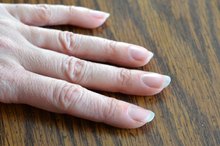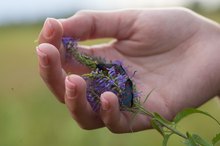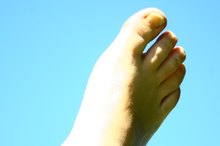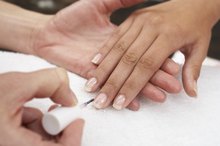What does fact checked mean?
At Healthfully, we strive to deliver objective content that is accurate and up-to-date. Our team periodically reviews articles in order to ensure content quality. The sources cited below consist of evidence from peer-reviewed journals, prominent medical organizations, academic associations, and government data.
- The Mayo Clinic: Ingrown Toenails
- American Academy of Family Physicians: Fungal Infections of Fingernails and Toenails
The information contained on this site is for informational purposes only, and should not be used as a substitute for the advice of a professional health care provider. Please check with the appropriate physician regarding health questions and concerns. Although we strive to deliver accurate and up-to-date information, no guarantee to that effect is made.
Nail & Cuticle Disorders
The nails on your fingers and toes play an important role in protecting the sensitive skin of your nail plate. The cuticle is also plays an role by sealing the nail bed off from bacterial and fungal infections. Both structures are a common target for bacteria, fungi and other health issues that can occur at any time, and for a variety of reasons.
Fungal Infection
One of the most common nail and cuticle disorders is a fungal infection 2. Fungal infection of the toenail are called onychomycosis. Fungal infections are typically caused by a type of fungus called dermatophytes. These fungi typically infect nails through cuts or open areas of skin, and spread from other people, or through contact with surfaces (such as a shower room floor) holding the fungi. According to the American Academy of Family Physicians, fungal infections occur more often in people over the age of 60, but can occur at any age 2.
Bacterial Infection
How to Heal a Damaged Cuticle
Learn More
Bacterial infections are another common nail and cuticle disorder that occur and spread the same way fungal infections do. These infections are commonly caused by exposure to Staphylococcus aureus or Streptococci bacteria, which attack the cuticle and cause an infection called paronychia.
Onychogryphosis
Onychogryphosis, also called ram's horn nail, is a disorder that occurs most commonly on the nail of the big toe. Onychogryphosis occurs when the toe nail thickens and begins to curve abnormally into a hook shape. This occurs when one side of the nail starts growing faster than the other. The disorder can cause injury to the surrounding toes due to the sharp edge of the hooked nail.
- Onychogryphosis, also called ram's horn nail, is a disorder that occurs most commonly on the nail of the big toe.
- Onychogryphosis occurs when the toe nail thickens and begins to curve abnormally into a hook shape.
Onycholysis
3 Possible Causes of Those Vertical Ridges on Your Fingernails
Learn More
Onycholysis is a nail disorder that affects the nail plate and bed. Onycholysis occurs when the nail experiences direct trauma, such as:
- improperly fitting shoes
- sports incident or stubbing
- resulting in the separation of the nail from the nail bed,
- in some cases
- the loss of the nail completely
The exposure of the skin beneath the nail raises the risk for further infection by bacteria or fungi if not kept dry and taken care of correctly.
Melanonychia Striata
Melanonychia striata is a nail disorder that causes pigment discoloration. In melanonychia striata cases, a brown strip of melanin appears running from the top of the nail to its base. Melanin is the pigment your body produces that gives your body structures, such as hair, skin and nails, their color. In most cases, the pigment change is nothing to worry about, but you should have your doctor examine it, as this can be a sign of skin cancer under or around the nail.
- Melanonychia striata is a nail disorder that causes pigment discoloration.
- In most cases, the pigment change is nothing to worry about, but you should have your doctor examine it, as this can be a sign of skin cancer under or around the nail.
Ingrown Toenail
Ingrown toenails are another common nail disorder that occurs when the nail grows unevenly and penetrates the surrounding flesh of the toe 1. This can cause uncomfortable pain and swelling around the affected nail. The ingrown toenail also cuts the skin, allowing the possibility of infection.
Hangnails
Hangnails are another common nail disorder which targets the skin around the nail bed. Hangnails are a torn piece of skin that occurs from your skin being too dry. According to the Mayo Clinic, you can prevent most hangnails by taking the time to regularly moisturize your hands 1. If you bite your nails, you're more likely to get hangnails.
- Hangnails are another common nail disorder which targets the skin around the nail bed.
Related Articles
References
- The Mayo Clinic: Ingrown Toenails
- American Academy of Family Physicians: Fungal Infections of Fingernails and Toenails
- Merck Manual Professional Version. Onychomycosis. Updated August 2019.
- Richardson M. Selecting a treatment option in subungual haematoma management. Nurs Times. 2004;100(46):59, 61, 63.
- MyHealth Alberta.ca. Toenail or fingernail avulsion: Care instructions.
Writer Bio
Chris Sherwood is a professional journalist who after years in the health administration field and writing health and wellness articles turned towards organic sustainable gardening and food education. He now owns and operates an organic-method small farm focusing his research and writing on both organic gardening methods and hydroponics.









